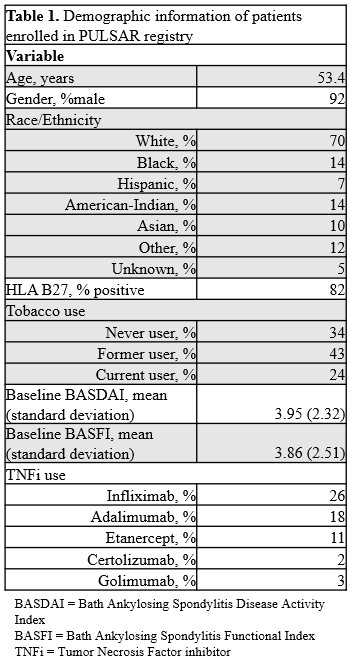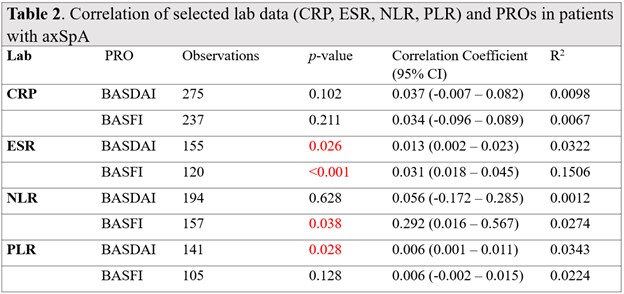Session Information
Session Type: Poster Session A
Session Time: 8:30AM-10:30AM
Background/Purpose: Biomarkers of disease activity/severity and imaging outcomes in axial spondyloarthritis (axSpA) remain a challenge. The most common relevant biomarker is the C-Reactive Protein (CRP), but it is elevated in only 60% of clinically active axSpA patients and demonstrates low specificity. Several epidemiologic studies have identified the neutrophil lymphocyte ratio (NLR) and platelet lymphocyte ratio (PLR) as useful tools in the characterization of inflammatory disease. In this study, we explored the utility of the NLR and PLR in axSpA and their associations with patient reported outcomes (PROs), CRP and the erythrocyte sedimentation ratio (ESR), and sacroiliac joint (SIJ) radiograph damage scores.
Methods: The study population consisted of US veterans with a clinical diagnosis of axSpA enrolled in the Program to Understand Long-term Outcomes of Spondylarthritis (PULSAR) registry. Included data were sociodemographics, PROs, and pharmacologic variables. Absolute neutrophil, platelet, and lymphocyte counts were extracted from the VA Corporate Data Warehouse (CDW). To moderate the effect of medications on lab values, analyses were restricted to encounters in which patients were not taking disease modifying anti-rheumatic drugs. SIJ 3-view radiographs (Ferguson and obliques) were evaluated by three blinded readers using the scoring from the modified New York (mNY) criteria. Associations between NLR and PLR and the CRP, PROs (BASDAI and BASFI), and radiograph scores were calculated using linear regression and plotted with a superimposed regression line (including 95% CIs). Cell count data were used only if they were same day as clinical data (apart from radiographs within 90 days of labs). Statistical analysis was performed using STATA/MP v15 software.
Results: In the PULSAR registry, a majority were white males, HLAB27 positive, and reported current or former tobacco use (Table 1). Of 254 patients with a diagnosis of axSpA, the NLR and PLR were both associated the CRP with p < 0.001 (Figure 1). The CRP however, was not significantly associated with BASDAI or BASFI. In contrast, the ESR was the only inflammatory marker with significant associations to both BASDAI (p = 0.026) and BASFI (p < 0.001). The NLR had statistically significant correlation with BASFI (p = 0.038) while the PLR had statistically significant correlation with BASDAI (p = 0.028) (Table 2). There was no significant correlation between radiographic scores by mNY criteria and CRP, ESR, NLR, or PLR.
Conclusion: In our cohort, axSpA patients were found to have specific correlations between the NLR, PLR and PROs, suggesting additional parameters for disease assessment in clinical practice. Radiographs however did not correlate with selected laboratory data, perhaps reflecting poor correlation of accumulative damage with the transient nature of inflammatory, NLR and PLR indices. Additional variables in larger numbers of axSpA patients may provide further guidance of the utility of these biomarkers.
To cite this abstract in AMA style:
Sen R, Kim E, Cheng E, Ganuthula K, Fang M, Kerr G, Walsh J, Chang E, Raychaudhuri S, Reimold A, Caplan L. A Tough Cell: The Argument for a Biomarker of Clinical and Imaging Outcomes in Spondyloarthritis: The Neutrophil Lymphocyte Ratio and the Platelet Lymphocyte Ratio [abstract]. Arthritis Rheumatol. 2021; 73 (suppl 9). https://acrabstracts.org/abstract/a-tough-cell-the-argument-for-a-biomarker-of-clinical-and-imaging-outcomes-in-spondyloarthritis-the-neutrophil-lymphocyte-ratio-and-the-platelet-lymphocyte-ratio/. Accessed .« Back to ACR Convergence 2021
ACR Meeting Abstracts - https://acrabstracts.org/abstract/a-tough-cell-the-argument-for-a-biomarker-of-clinical-and-imaging-outcomes-in-spondyloarthritis-the-neutrophil-lymphocyte-ratio-and-the-platelet-lymphocyte-ratio/



